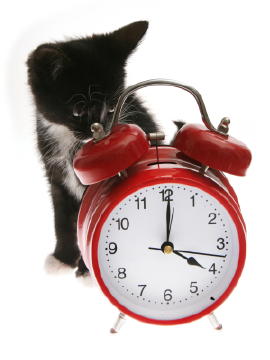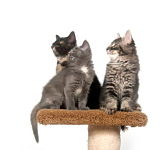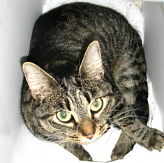Cat Internal Clock ...a cat behavior and built in dinner bell

When I saw the "cat internal clock" of my brood not reacting much to the time change, I was reminded that when we changed the clocks from Standard Time to Daylight Savings Time, that I had done a smart thing...so I patted myself on the back.
What I did was start changing the meal times gradually so that I would be in synch with their internal clocks when the time changed. The cats had been fed around 8 a.m. and 5 p.m. so I slowly, over the period of a couple of months, moved them ahead a minute or so a day until they ate at 9 a.m. and 6 p.m. Max and Chanel#5 are the main two who seem to be clock-watching.
Perhaps they were the neediest when we brought them into our household. A cat internal clock can vary somewhat from cat to cat and I always wondered how my cats figured out the time.
Cats have a built in biological cycle, a cat internal clock, that guides many aspects of its life. These cycles are like internal "timers" set a different times. High-frequency rhythms last for less than 30 minutes and control activities such as heart and respiration rates. Ultradian rhythms which are responsible for changes in body temperature and appetite are timed to last longer than 30 minutes but less than 20 hours. Circannual rhythms are seasonal and affected by light. This one governs changes such as hair growth and mating patterns.
Our indoor cats adjust readily to changes so we have to look at cats in their natural state in the wild. Since homeless cats are exposed to the elements year round it's not surprising that they go through more marked seasonal adjustments than their domestic counterparts.
The main seasonal change is not temperature but exposure to daylight known as photoperiod. As the photoperiod decreases in late summer, outdoor cats living in northerly regions grow longer hair in readiness for the chill of winter's arrival.
Another seasonal change influenced by the photoperiod is the female cat's sexual cycle called estrous cycle. Unspayed female cats are seasonally polyestrous. For about 9 months out of the year, they go through estrous cycles where they are receptive to males, but during the 3 month period from October through December when the photoperiod is shortest, females usually stop cycling.
The photoperiod also influences the hunting cat's timetable. Hunting cats typically are most active at sunrise and sunset when they have hunger. As days become shorter prey animals adjust the timing of their activities to coincide with their cat internal clock. When homeless cats feel the bite of winter and food is more scarce, cats conserve their energy when not seeking food by going to sleep.
Homeless cats that live in close proximity to people don't necessarily follow nature's rules. A study done years ago showed that cats moved their peak of activity from sunset to 1 a.m. to avoid contact with people and dogs. Cats are flexible and can adapt the cat internal clock. They are not dominated by their biology.
Located in the hypothalamus, the area of the brain that regulates your cat's eating and sleeping patterns and sexual activities...is a cluster of cells called the suprachiasmatic nucleus (SCN). Scientists believe the SCN plays the role of a master biological clock keeping rhythms performing as they should. The controller of this master clock is light.
When light plays on the retina at the back of the eye it stimulates a chemical reaction that sends electrical signals along a pathway of nerves (the retinohypothalamic tract) to the SCN. This dedicated pathway provides the biological clock with light/dark information.
This pathway is distinct from the pathway that sends visual information from the cat's eyes to the areas of its brain that control vision. Therefore, even a blind cat can still tell the time of day.
The domestic cat, unlike the homeless cat, lives in an environment where there is light, heat and lots of food year round so its body has adjusted to a world of no seasons. However, Mother Nature isn't entirely fooled. You may notice that your cat's coat gets a little longer in the winter and it tends to shed a little all year long.
Related Articles......
Return from Cat Internal Clock to Cat Health Homepage
Having trouble finding what you need? Cat Health Index & Site Map
OR
Do you have a question to ask?...Questions
OR
Do you have a cat story to share?...Simply click here to go to that page!
Copyright@2010-2020 All rights reserved.Cat-health-detective.com
This website is information only. Consult a veterinarian for medical assistance

"Like Us" on Facebook
or...
"Like Us" here




















